
Consumer Insights
Uncover trends and behaviors shaping consumer choices today
Procurement Insights
Optimize your sourcing strategy with key market data
Industry Stats
Stay ahead with the latest trends and market analysis.
Trending Now


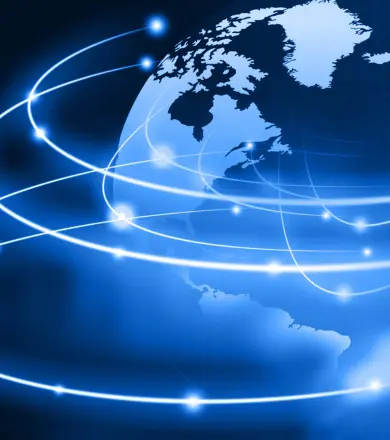
The global heating equipment market reached a value of nearly USD 44.44 Billion in 2024. The market is assessed to grow at a CAGR of 5.80% during the forecast period of 2025-2034 to attain a value of around USD 78.10 Billion by 2034. The growing adoption of smart home technology, the rising demand for energy-efficient heating machinery, favourable government initiatives, increasing focus on sustainability, and innovations in heating equipment are driving the market.
Base Year
Historical Year
Forecast Year






Value in USD Billion
2025-2034
Heating Equipment Market Outlook
*this image is indicative*
The need for energy-efficient heating machinery has resulted in mechanical devices being developed that could provide cost-effective heating, which is aiding the growth of the market. With rapid technological growth, the heating equipment provides cost-effective alternatives for reducing carbon emissions; thus, further propelling the growth of the heating equipment market. These systems can either be categorised as self-contained packages of units or as core systems. The self-contained packages are generally used in residential and small business areas. In big commercial buildings, where access to outside air is limited, central heating systems are used. Many building standards directly influence the heating equipment sector.
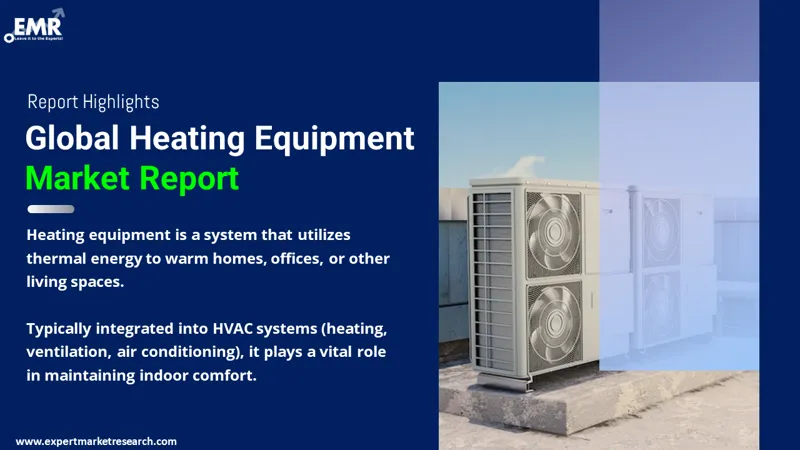
Read more about this report - REQUEST FREE SAMPLE COPY IN PDF
Ductless mini-split heat pumps are becoming more popular for both residential and commercial applications, especially in older buildings where installing ductwork can be too costly or impractical. These systems are easy to install, minimise energy losses associated with ductwork, and deliver accurate heating and cooling, making them ideal for retrofitting and spaces with specific climate control needs, further increasing the heating equipment market revenue.
The demand for ductless mini-split has seen significant growth in recent years, largely due to increased consumer awareness of energy-efficient solutions. Many units now showcase impressive Seasonal Energy Efficiency Ratio (SEER) ratings, with some models reaching as high as 42 SEER in recent years. This high efficiency leads to substantial savings on utility bills, as these systems adjust their operation to meet heating or cooling needs. Additionally, mini-splits are generally easier to install than ducted systems and require less maintenance, making them a cost-effective option for both homeowners and businesses.
Favourable government initiatives; rising focus on sustainability; increasing trend of home automation; and innovations by key players are favouring the heating equipment market development.
It is anticipated that initiatives such as the United States’ Leadership in Energy and Environmental Design (LEED) will help the development of the sector. In the coming years, the demand for industrial furnaces in the United States is anticipated to rise due to the rise in industrial sector refurbishment and renovation. Moreover, it is also expected that the existence of a strict legislative structure pertaining to HVAC systems and building regulations will fuel the heating equipment demand over the forecast period. A multi-state initiative led by the Building Decarbonisation Coalition in the USA has set ambitious goals for boosting the adoption of heat pumps, aiming for a 65% market penetration by 2030. States such as California, New York, and Massachusetts are involved in this effort to advance building decarbonisation, with the goal of making heat pumps a commonly used heating solution. This collaborative project underscores the United States' dedication to reducing greenhouse gas emissions in both residential and commercial buildings.
The growing focus on sustainability and the shift towards eco-friendly, energy-efficient, and low-carbon technologies are boosting the heating equipment market revenue. There is a rising demand for energy-efficient heating systems integrated with technologies such as condensing boilers and radiant heating systems among businesses and consumers to lower energy bills and reduce environmental footprints. Stringent regulations regarding energy efficiency and emissions are encouraging manufacturers to design heating systems that comply with higher performance standards. Key players are also shifting from fossil fuel-based systems (such as oil or natural gas boilers) towards low-carbon heating technologies such as hydrogen boilers and electric heat pumps. In the forecast period, the development of hydrogen-based heating systems that produce zero carbon emissions when burned is anticipated to aid the market.
The increasing integration of home automation technologies and smart heating systems is revolutionising the heating equipment market landscape. Connected heating systems and smart thermostats equipped with algorithms that can optimise energy use by adjusting heating schedules as per the user’s preferences are gaining popularity. Moreover, IoT integration enables homeowners to monitor heating systems in real time, hence detecting inefficiencies, malfunctions, or unexpected usage patterns. The growing integration of smart homes enables the personalisation of heating systems with the preferences and habits of users, ensuring consistent comfort. In addition, smart heating systems integrate popular voice assistants such as Google Assistant, Amazon Alexa, and Apple HomeKit to enable users to adjust temperatures with simple voice assistants, enhancing accessibility and convenience. In the forecast period, manufacturers are expected to introduce heating equipment with built-in smart capabilities, including energy tracking, app control, and automated operation.
The heating equipment market value is fuelled by technological developments, along with government initiatives to improve energy efficiency across sectors. It is also expected that the growing expenditure in the building industry will add to the product demand in the coming years. The global market is extremely competitive, and major businesses are concentrating on minimising the general cost of the item by leveraging the high technology price and assembly costs. Heat pumps represent a significant technological advancement, with innovations like dual-source and geothermal systems becoming increasingly popular. Dual-source heat pumps integrate both air and ground sources, enhancing efficiency across different climate conditions. Geothermal heat pumps further take advantage of consistent underground temperatures, offering dependable and efficient heating and cooling solutions. The US government is supporting their implementation through the Inflation Reduction Act, which offers incentives to promote the adoption of heat pumps and play a crucial role in lowering energy consumption and reducing greenhouse gas emissions.
Favourable government initiatives, such as the U.S. Leadership in Energy and Environmental Design (LEED) and multi-state efforts to promote heat pumps, are driving demand for energy-efficient heating systems. Sustainability trends are encouraging the shift from fossil fuels to low-carbon technologies, including hydrogen boilers and electric heat pumps. Smart heating systems integrated with home automation and IoT technologies are enhancing user comfort and energy efficiency. Innovations like dual-source and geothermal heat pumps are gaining popularity, with government incentives supporting their adoption. These advancements, combined with increasing investments in the building sector, are expected to boost the heating equipment market growth.
Heating systems are increasingly incorporating renewable energy sources. For instance, solar-powered HVAC systems and geothermal heat pumps leverage natural energy, which reduces reliance on fossil fuels and helps lower carbon emissions. This trend of heating equipment market is particularly significant in areas focused on decarbonisation and energy independence, as more homes and businesses adopt sustainable energy solutions for their heating and cooling requirements.
As per the International Energy Agency (IEA) report, in 2023, global renewable energy capacity increased by 50% compared to the previous year, a trend expected to continue as the focus on decarbonisation intensifies. This expansion includes the use of renewable energy for heating, particularly in residential and commercial sectors, where there is a strong demand for sustainable energy solutions. Moreover, in Northern China, a shift from coal to geothermal energy for district heating is underway, which not only reduces pollution but also meets urban heating needs sustainably. This transition is encouraging homeowners and businesses to adopt cleaner energy options for their heating and cooling requirements.
Manufacturers and consumers are increasingly facing challenges due to inflation and rising production costs. The increase in energy prices, along with the costs associated with new, eco-friendly refrigerants, is pushing up the prices of heating systems. This situation is further affected by the phase-out of high-GWP refrigerants like R-410A, necessitating a quick transition to alternative options for manufacturers. Many consumers are choosing to repair their current systems instead of purchasing new ones, resulting in a decrease in demand for heating equipment in both residential and commercial markets, which ultimately affects the heating equipment demand growth.
Moreover, ongoing supply chain disruptions are impacting the availability and cost of essential materials such as copper, aluminium, and semiconductors, which are essential for HVAC component manufacturing. These shortages have caused significant price increases. For instance, copper prices have increased by around 80% compared to last year, further increasing the overall rise in equipment costs.
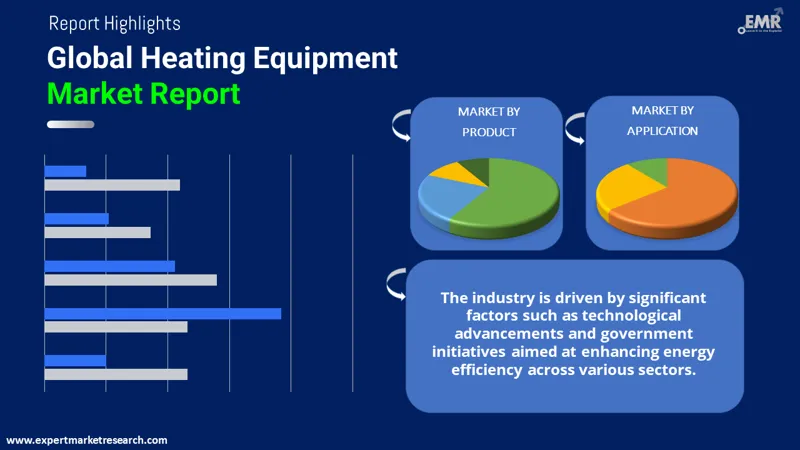
Read more about this report - REQUEST FREE SAMPLE COPY IN PDF
“Global Heating Equipment Market Report and Forecast 2025-2034” offers a detailed analysis of the market based on the following segments:
The industry can be divided based on product as:
The industry can be broadly categorised based on application into:
The EMR report looks into the regional heating equipment markets like:
By Product Insights
Heat pumps are leading the heating equipment market share, primarily due to their energy efficiency and beneficial environmental effects. Their increasing popularity is due to their ability to provide both heating and cooling from a single unit, making them attractive for both residential and commercial applications. Several regions are encouraging the adoption of heat pumps through government incentives aimed at enhancing energy efficiency and achieving decarbonisation goals. Furthermore, heat pumps' ability to integrate with renewable energy sources, such as solar power, makes them a sustainable choice in modern HVAC systems.
Furnaces are also gaining popularity in the market as they are a preferred heating option in colder areas, particularly in the residential sector, where their reliability and efficiency in offering consistent warmth is important.
Boilers, typically used for hot water production and space heating, can be powered by different fuels, including oil, natural gas, electricity, biomass, and propane. With surging energy prices and stringent energy efficiency regulations, the preference for condensing and high-efficiency boilers are witnessing a surge in demand. In the forecast period, smart boilers, integrated with IoT technology that can enable remote control and monitoring, are expected to witness a rise in demand.
Unitary heaters provide quick and efficient warmth in smaller areas like individual rooms, apartments, and office spaces. The rising demand for ductless systems that provide both heating and cooling and the growing adoption of energy-efficient unitary heaters are increasing the heating equipment market revenue.
By Application Insights
The residential sector accounts for a major market share due to the increasing consumer preference for energy-efficient heating solutions, especially in colder areas where dependable heating is essential, boosting the overall demand of heating equipment market. There is also a trend towards sustainable alternatives, such as heat pumps and energy-efficient boilers, which reflects consumers' growing awareness of environmental issues and their desire to reduce household energy costs.
Meanwhile, the commercial sector growth is driven by the rising demand for advanced heating systems in commercial settings, including offices, hospitals, and retail spaces, where reliable and efficient heating is crucial for both comfort and operational effectiveness.
As per the heating equipment market analysis, the industrial sector, encompassing industries such as food production, manufacturing, and chemical processing, requires robust heating equipment that can withstand high temperatures and operate continuously over long periods.
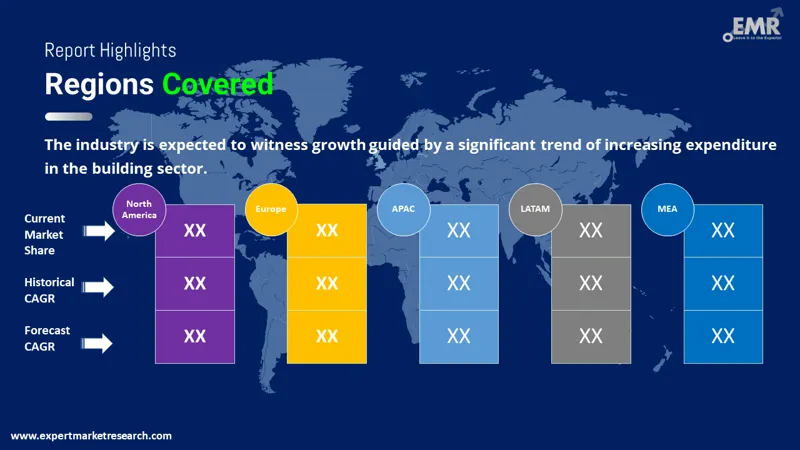
Read more about this report - REQUEST FREE SAMPLE COPY IN PDF
North America Heating Equipment Market Growth
The market growth is driven by a growing focus on green building initiatives and energy-efficient technologies. For instance, the Biden administration allocated around USD 250 million from the Inflation Reduction Act (IRA) to boost domestic production of heat pumps. As per the heating equipment industry analysis, this funding is intended to encourage the manufacturing of electric heat pumps, facilitating the adoption of clean energy in homes and helping families reduce their energy bills.
Additionally, the IRA offers tax credits of up to USD 2,000 for households that choose to install energy-efficient heat pumps, potentially resulting in an average savings of USD 500 on annual heating costs.
Europe Heating Equipment Market Drivers
Europe, particularly Western Europe has established itself as a major market for heating equipment, owing to stringent environmental regulations aimed at reducing carbon emissions. Countries such as Germany and France are heavily investing in sustainable heating technologies, including advanced heat pumps and hybrid systems that incorporate renewable energy sources and enhance heating equipment market opportunities. For instance, in Germany, the government has introduced the new Building Energy Act, effective from January 2024, mandating that all newly installed heating systems use at least 65% renewable energy. This act is part of a broader effort to reduce reliance on fossil fuels and meet Germany's climate goals.
Asia Pacific Heating Equipment Market Trends
The Asia Pacific region is one of the fastest-growing markets for heating equipment, owing to the rise in urbanisation and industrialisation in countries such as China and India. A rise in disposable incomes, a rise in construction activities, and government initiatives supporting energy-efficient infrastructure projects are all contributing to the growth of the heating equipment industry.
For instance, the Asian Development Bank (ADB) has substantially increased its funding by allocating USD 100 billion for climate-resilient projects across Asia by 2030. This funding is expected to support various initiatives such as the deployment of renewable energy solutions and the integration of high-end technologies into infrastructure development.
Latin America Heating Equipment Market Overview
The market in Latin America is witnessing significant growth as several countries adopt more energy-efficient technologies. This development is supported by increasing awareness of environmental issues and a shift towards sustainable solutions in both residential and commercial sectors, which positively impacts the heating equipment demand forecast.
Countries such as Colombia and Chile have seen substantial investments in sustainable energy infrastructure. For instance, Colombia has adopted a strategy to decrease HFCs in its refrigeration systems. The new regulation bans the production and importation of refrigerators that use this substance, marking a significant achievement of the joint efforts between the government and the NAMA Facility-funded NAMA Support Project (NSP), especially the Colombia Domestic Refrigeration initiative.
Middle East and Africa Heating Equipment Market Dynamics
The market growth in the Middle East and Africa is primarily driven by the increasing demand for cooling systems, but there is also a significant rise in interest in energy-efficient heating solutions. As per the heating equipment market dynamics and trends, the high temperatures common in many MEA countries have led to regulatory support for systems that use environmentally friendly refrigerants.
For instance, In Jordan, a project launched by the Climate and Clean Air Coalition (CCAC) implemented the region's first CO2-based refrigeration system at a supermarket in Amman. This transcritical COâ‚‚ system replaced traditional HFC and HCFC refrigerants, offering a more environmentally friendly option.
Startups are focusing on heat pumps that offer eco-friendly heating options by harnessing renewable energy sources. They are offering heat pump that reduces carbon emissions, appealing to environmentally conscious consumers looking for low-impact heating solutions. Moreover, they are readily leveraging geothermal technology to access stable underground temperatures, enabling efficient heating and cooling, which helps reduce energy costs and carbon footprints in both residential and commercial settings. Additionally, some startups are focused on providing IoT-based solutions that enable remote management and monitoring of HVAC systems, which further aids the heating equipment industry revenue.
Gradient
This U.S.-based startup aims to offer low-carbon heating solutions with user-friendly designs. Its flagship product is a high-efficiency heat pump that can be installed on windows, providing sustainable heating and cooling while maintaining clear views. Gradient’s cutting-edge technology reduces reliance on traditional HVAC systems, offering an eco-friendly alternative that lowers carbon emissions, making it especially ideal for urban residential settings.
GeoAirCon
GeoAirCon, based in Pakistan, specialises in geothermal heating and cooling technologies. By harnessing the stable temperatures found underground, their systems provide a renewable heating source that significantly reduces energy consumption and greenhouse gas emissions. GeoAirCon's technology incorporates geothermal coils and HDPE piping, which are adaptable for a wide range of applications, from residential to industrial, among others.
The report presents a detailed analysis of the following key players in the global heating equipment market, looking into their capacity, market shares, and latest developments like capacity expansions, plant turnarounds, and mergers and acquisitions. Major market players are developing technologies that focus on environmentally sustainable and highly efficient heating solutions. For example, some companies have introduced high-temperature heat pumps that use hydrofluoroolefins (HFOs), recognised as a more environmentally friendly refrigerant alternative. These heat pumps are versatile and capable of extracting heat from diverse sources such as data centres and hotels, contributing to lower carbon emissions and enhanced energy efficiency.
Danfoss, founded in 1933 and based in Denmark, specialises in engineering technologies aimed at enhancing energy efficiency and reducing environmental impact. The company operates across various sectors, including cooling, heating, drives, and power solutions, with a strong emphasis on sustainable and intelligent solutions for HVAC and refrigeration systems.
Carrier Global, which was formerly part of United Technologies Corporation, became an independent company in the heating equipment market in 2020. It is known as a global provider of HVAC, refrigeration, and fire and security solutions.
Trane Technologies, previously known as Ingersoll-Rand, emerged as a separate company in 2020. It provides a wide range of climate control solutions, including HVAC systems designed for residential, commercial, and industrial applications, among others.
*Please note that this is only a partial list; the complete list of key players is available in the full report. Additionally, the list of key players can be customized to better suit your needs.*
Other major players in the market are Raytheon Technologies Corporation, Lennox International, Inc., Rotex Heating Systems GmbH [Daikin Industries, Ltd.], and Robert Bosch GmbH, among others.
*While we strive to always give you current and accurate information, the numbers depicted on the website are indicative and may differ from the actual numbers in the main report. At Expert Market Research, we aim to bring you the latest insights and trends in the market. Using our analyses and forecasts, stakeholders can understand the market dynamics, navigate challenges, and capitalize on opportunities to make data-driven strategic decisions.*
Get in touch with us for a customized solution tailored to your unique requirements and save upto 35%!
In 2024, the market reached an approximate value of USD 44.44 Billion.
The market is projected to grow at a CAGR of 5.80% between 2025 and 2034.
The major drivers of the market include technological developments, along with government initiatives to improve energy efficiency across sectors.
The growing expenditure in the building sector is expected to be a key trend guiding the growth of the market.
The major regions in the market are North America, Latin America, the Middle East and Africa, Europe, and the Asia Pacific.
The types of heating equipment available are heat pumps, furnaces, boilers, and unitary heaters, amongst others.
Heating equipment finds applications in residential, commercial, and industrial sectors.
The major players in the global heating equipment market are Danfoss A/S, Carrier Global Corporation [United Technologies Corporation], Trane Technologies plc (Ingersoll-Rand plc), Raytheon Technologies Corporation, Lennox International, Inc., Rotex Heating Systems GmbH, and Robert Bosch GmbH, among others.
The market is estimated to witness healthy growth in the forecast period of 2025-2034 to reach a value of around USD 78.10 Billion by 2034.
Explore our key highlights of the report and gain a concise overview of key findings, trends, and actionable insights that will empower your strategic decisions.
| REPORT FEATURES | DETAILS |
| Base Year | 2024 |
| Historical Period | 2018-2024 |
| Forecast Period | 2025-2034 |
| Scope of the Report |
Historical and Forecast Trends, Industry Drivers and Constraints, Historical and Forecast Market Analysis by Segment:
|
| Breakup by Product |
|
| Breakup by Application |
|
| Breakup by Region |
|
| Market Dynamics |
|
| Competitive Landscape |
|
| Companies Covered |
|
| Report Price and Purchase Option | Explore our purchase options that are best suited to your resources and industry needs. |
| Delivery Format | Delivered as an attached PDF and Excel through email, with an option of receiving an editable PPT, according to the purchase option. |
Datasheet
One User
USD 2,499
USD 2,249
tax inclusive*
Single User License
One User
USD 3,999
USD 3,599
tax inclusive*
Five User License
Five User
USD 4,999
USD 4,249
tax inclusive*
Corporate License
Unlimited Users
USD 5,999
USD 5,099
tax inclusive*
*Please note that the prices mentioned below are starting prices for each bundle type. Kindly contact our team for further details.*
Flash Bundle
Small Business Bundle
Growth Bundle
Enterprise Bundle
*Please note that the prices mentioned below are starting prices for each bundle type. Kindly contact our team for further details.*
Flash Bundle
Number of Reports: 3
20%
tax inclusive*
Small Business Bundle
Number of Reports: 5
25%
tax inclusive*
Growth Bundle
Number of Reports: 8
30%
tax inclusive*
Enterprise Bundle
Number of Reports: 10
35%
tax inclusive*
How To Order
Our step-by-step guide will help you select, purchase, and access your reports swiftly, ensuring you get the information that drives your decisions, right when you need it.

Select License Type
Choose the right license for your needs and access rights.

Click on ‘Buy Now’
Add the report to your cart with one click and proceed to register.

Select Mode of Payment
Choose a payment option for a secure checkout. You will be redirected accordingly.
Gain insights to stay ahead and seize opportunities.
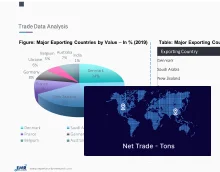
Get insights & trends for a competitive edge.
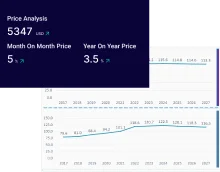
Track prices with detailed trend reports.
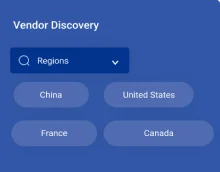
Analyse trade data for supply chain insights.
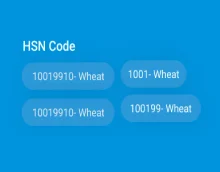
Leverage cost reports for smart savings
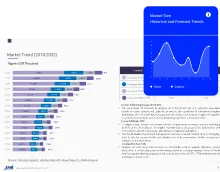
Enhance supply chain with partnerships.
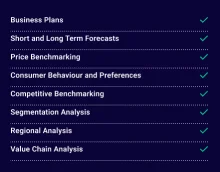
Connect For More Information
Our expert team of analysts will offer full support and resolve any queries regarding the report, before and after the purchase.
Our expert team of analysts will offer full support and resolve any queries regarding the report, before and after the purchase.
We employ meticulous research methods, blending advanced analytics and expert insights to deliver accurate, actionable industry intelligence, staying ahead of competitors.
Our skilled analysts offer unparalleled competitive advantage with detailed insights on current and emerging markets, ensuring your strategic edge.
We offer an in-depth yet simplified presentation of industry insights and analysis to meet your specific requirements effectively.



Australia
63 Fiona Drive, Tamworth, NSW
+61-448-061-727
India
C130 Sector 2 Noida, Uttar Pradesh 201301
+91-723-689-1189
Philippines
40th Floor, PBCom Tower, 6795 Ayala Avenue Cor V.A Rufino St. Makati City,1226.
+63-287-899-028, +63-967-048-3306
United Kingdom
6 Gardner Place, Becketts Close, Feltham TW14 0BX, Greater London
+44-753-713-2163
United States
30 North Gould Street, Sheridan, WY 82801
+1-415-325-5166
Vietnam
193/26/4 St.no.6, Ward Binh Hung Hoa, Binh Tan District, Ho Chi Minh City
+84-865-399-124
United States (Head Office)
30 North Gould Street, Sheridan, WY 82801
+1-415-325-5166
Australia
63 Fiona Drive, Tamworth, NSW
+61-448-061-727
India
C130 Sector 2 Noida, Uttar Pradesh 201301
+91-723-689-1189
Philippines
40th Floor, PBCom Tower, 6795 Ayala Avenue Cor V.A Rufino St. Makati City, 1226.
+63-287-899-028, +63-967-048-3306
United Kingdom
6 Gardner Place, Becketts Close, Feltham TW14 0BX, Greater London
+44-753-713-2163
Vietnam
193/26/4 St.no.6, Ward Binh Hung Hoa, Binh Tan District, Ho Chi Minh City
+84-865-399-124
Share